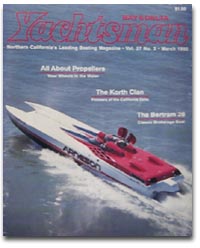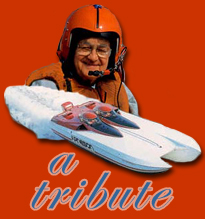|
|

About the Bay
Out for a spin – at 140 mph
By Bill Parks
Featured
in: Bay & Delta Yachtsman
March 19
Going for a boat ride with Howard Arneson is unlike any
other experience, except maybe taking off in a jet. There are lots
of similarities. Arneson’s new 40ft offshore catamaran is powered
by two gas turbine engines, so the boat makes a loud, high pitched
whine, a lot like a jet plane.
But the real
similarity hits when he puts the hammer down, and the twin 1,325-hp
engines blast you to more than 100mph in well under a quarter mile.
The force slams you back into the padded bucket seat like you were
in the seat of a 747 making its takeoff run.
"This isn’t boating", you cant’
help thinking. "This is something else". On our test run out of Loch Lamond Marina, the Bay was choppy, rain was threatening, and
sailboats were leaning over sharply from the wind. It didn’t seem like a
day to be careening around San Francisco Bay at more than 100 mph, but to
Howard Arneson, it was just another day at the office.
"Can you see the speedometer?", he
asked through the headset radio in my helmet. "Watch the needle on
the outside ring. Remember where to find it because we’ll be bouncing
around a lot today. Answer when I talk, because I can’t see you
nod."
 We sat on either side of the boat, looking out at windshield
cowlings built for F-16 fighter planes. We closed the hatches and
fastened the rubber latches, rounded the first piling marking the
entrance to Loch Lamond Marina and turned into the wind.
We sat on either side of the boat, looking out at windshield
cowlings built for F-16 fighter planes. We closed the hatches and
fastened the rubber latches, rounded the first piling marking the
entrance to Loch Lamond Marina and turned into the wind.
Under the
roll bars and through the network of pipes and braces between us, I could
see Arneson’s hand on the throttle.
The twin turbine engines roared and we were
pressed back into our seats. The waves rushed towards us so fast that it
seemed unreal – like a videotape on fast forward. We were at the mouth
of the San Rafael Canal in seconds. Water passed in a blur as the waves
hammered the hull in a steady roar. The bigger waves slammed the hull with
solid BANGS. We were airborne much of the time. The friction of the boat’s
hull against the water made a squeaking sound, like a jetliner’s wheels
hitting the runway. The speedometer’s needle jumped past 100.
We neared shore and slowed a bit to turn for
another run. "Did you see the speedometer?", Arneson said
through the headset, "I think we hit 120", I said. "You’re
looking at the wrong ring", he said, "We were going faster than
that."
On the next run, the speedo hit 140.
 We slowed in the channel, Arneson cut the turbines and started up
the Yamaha jet drive outboard he uses for maneuvering in and out of
the harbors. We loaded the 40-ft catamaran on its trailer and drove
to what Arneson calls his "toy shop" in San Rafael.
We slowed in the channel, Arneson cut the turbines and started up
the Yamaha jet drive outboard he uses for maneuvering in and out of
the harbors. We loaded the 40-ft catamaran on its trailer and drove
to what Arneson calls his "toy shop" in San Rafael.
Arneson used profits from his successful
automatic pool sweep business to develop his surface drive business in
1980. The drive concept – like all good ideas – is so simple and
obvious that you wonder why it wasn’t always done this way.
With the surface drive, the propeller shaft
extends from the back of the boat instead of underneath. A universal joint
and vertical hydraulic adjustment keep only the lower half of the
propeller in the water. Steering is accomplished with a horizontal
hydraulic cylinder.
 The result is less drag, because there is no
strut, shaft, or rudder dragging through the water under the boat. And,
keeping only half of the propeller under water allows a higher operating
RPM and more efficient than keeping the propeller completely underwater. The surface drive has gained wide acceptance
amongst offshore racers, a recent European yearbook listed 21 of 32
boats with Arneson drives – and they are showing up on mega yachts, work
boats, and even some military ships. The result is less drag, because there is no
strut, shaft, or rudder dragging through the water under the boat. And,
keeping only half of the propeller under water allows a higher operating
RPM and more efficient than keeping the propeller completely underwater. The surface drive has gained wide acceptance
amongst offshore racers, a recent European yearbook listed 21 of 32
boats with Arneson drives – and they are showing up on mega yachts, work
boats, and even some military ships.
"There aren’t enough hours in the
day", he said sipping a diet soft drink in his trophy studded office,
with his sidekick – a "purebred mutt" named Cody. "If I
wasn’t doing this, I’d have to start acting my age – and that would
be disastrous!" Arneson will be 71 this year.
His previous boat, a single turbine 32 footer
painted red like the current 40 footer, was a familiar sight around the
bay, belching up a 6-foot flame out of the exhaust. In September, 1990,
Arneson raced that boat up the Mississippi River from New Orleans to St.
Louis to smash the record by seven and a half-hours. He covered the 1,039
miles in 12 hours, 40 minutes, and 50 seconds. He even beat his support
truck, even though it is 350 miles shorter by road.
"We were averaging more than 100 mph,
when we were running", Arneson said. "But we had to keep slowing
down for the barge traffic." He said the barges cost more time than
the four times they refueled. Despite the barge delays, floating debris,
and the narrow channels – some only 100 feet wide – Arneson says that
his record will probably stand until he takes another crack at it in his
new boat.
 But first, he will probably go after the San
Francisco to Los Angeles record with the new boat, or maybe the
Ketchikan-Seattle mark. With good weather and barring encounters with
floating logs, Arneson is confident the boat will put on a good show. But first, he will probably go after the San
Francisco to Los Angeles record with the new boat, or maybe the
Ketchikan-Seattle mark. With good weather and barring encounters with
floating logs, Arneson is confident the boat will put on a good show.
The boat is a Skater catamaran hull,
constructed of carbon fiber with end grain balsa core, built by Douglas
Marine. Overall length is 40 ft, beam is 11 feet, and it draws only 8
inches when running at speed. It has twin gas turbine G.E.T-58 helicopter
engines, each one driving an Arneson No. 8 surface drive with a six bladed
prop. Despite their 1,325-hp output, each engine weighs only 300 pounds.
Dry, the boat weighs 9,180 pounds, but with four passengers, and 850
gallons of jet fuel on board, it weighs nearly 16,000 pounds. Arneson has
about $600,000 invested in the boat. He says it will hit 160 mph when the
conditions are right.
Arneson makes routine test runs that seem
incredible to the boaters familiar with the Bay and Delta distances.
Leaving Loch Lamond near San Rafael, Arneson can be at Benecia in 10
minutes, Tower Park in 35.
"That’s just loafing along," he
said. "That’s running at about 80 percent power. I slow down to 100
mph."
 What’s Arneson’s next boat? What’s Arneson’s next boat?
"I don’t know – there may be a 50
footer in my future. It seems like you’re always a boat behind in life…."
To subscribe to this fine
magazine contact:
Recreation Publications
4090 S. McCarran
Suite E
Reno, Nevada 89502
phone: (510) 865-7500
fax: (510) 865-0186 |
Arneson
Industries
Rare
"Classified"
Photo
 |